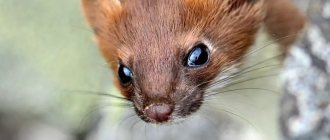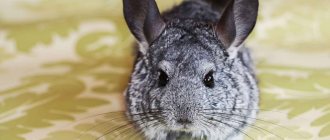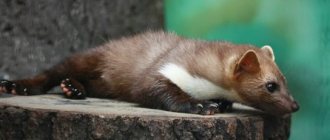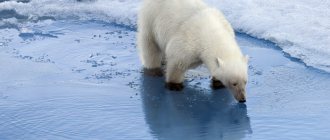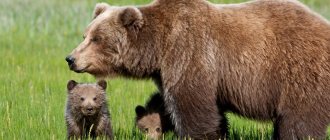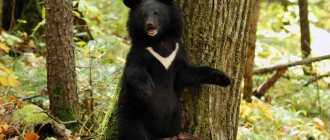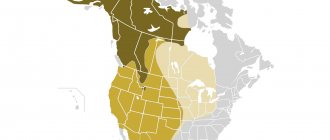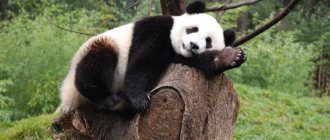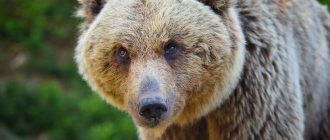Description, structure, characteristics
The ermine is a very small animal, its body length is only about 30 cm. Also another 12 cm is accounted for by the ermine's long tail. The body of this animal itself has an elongated shape, and its legs, on the contrary, are short. However, the stoat's short legs allow it to run relatively quickly and also climb trees.
The ermine's elongated neck is crowned by a triangular head with small rounded ears. Despite the fact that the ermine's ears are small, this animal has excellent hearing, as well as vision and sense of smell.
The average weight of an ermine is about 260 grams. Moreover, males are usually twice as large as females.
The same painting by Leonardo da Vinci - “Lady with an Ermine”.
Stoats have the amazing ability to change their color depending on the time of year. So in winter, the ermine becomes completely white, its color practically merging with the surrounding snow. Such color mimicry helps these animals both to hunt more successfully and to hide from other larger predators. Also, in winter, ermine fur becomes especially thick and soft, warming its owner more.
In the summer, the ermine transforms: its fur thins out, becoming tougher and sparse. Its color also changes, the upper part of the animal’s body becomes reddish-brown, and the lower part yellowish-white. And only the tip of the tail remains black at any time of the year.
Spring and autumn are the time of transition for the ermine, at this time these animals molt, and in the spring the ermine's molting begins with the head, then the body, then the tail, and in the fall everything happens in strictly the reverse order.
Housing
These animals live in rock cracks, bushes, inside trees and in underground burrows. They often use ready-made rodent structures for housing. The mink can sometimes be lined with dry grass or the skins of its prey. Females are especially prone to this during pregnancy.
Near a person, stoats can choose a pile of firewood or stones or a haystack as housing.
The ermine marks the territory in which it lives with a special secret. The size of their own possessions varies from ten to twenty hectares (for males they are twice as large as for females).
Difference from weasel
The ermine is often confused with another animal - the weasel, which is really very similar to it. Let's look at the differences between a weasel and an ermine.
Weasel and ermine.
Appearance
An adult stoat has a total body length of 170 to 330 mm, with about 35% of this length being in the tail. Males grow to be approximately twice the size of females. The body shape of an ermine is very similar to that of a weasel: long, like a ribbon, with short legs, a pointed muzzle, and small ears. His eyes look like black beads. In summer, the fur is chocolate brown in color, while in winter the fur is snow-white, with the exception of the tip of the tail - it is colored black. Winter color is typical for areas where there is snow for at least 40 days a year.
Habitats
Where does the ermine live? The ermine's habitat is very wide - it covers almost the entire northern hemisphere of our planet. Stoats live in North America in Canada and in the northern states of the USA, also in northern Eurasia. Stoats live mainly in forest-steppe, tundra, river valleys and taiga.
Interesting fact: stoats were somehow specially brought to New Zealand so that they would reduce the local population of rabbits, known for their fertility. But nothing good came of such an experiment, since, having bred in New Zealand, stoats began to destroy not only rabbits, but also many rare local birds, in particular the New Zealand kiwi bird, which was introduced into
Red Book.
Description and origin of the species
Ermine ( Mustela erminea
) belongs to the class Mammals (Mammalia), order Carnivora (Carnivora), family Mustelidae, genus Ferrets and weasels (Mustela). The name and scientific description of the animal was first given by the Swedish zoologist Carl Linnaeus in 1758.
The Latin name of the species, erminea, and the English name, ermine, come from Armenia, where the animals were previously thought to have appeared first. According to another version, the word ermine was borrowed by the Normans from the Teutonic harmin or Anglo-Saxon hearma. The origin of the word “ermine” is unknown, but the name from Old Slavic passed into the Russian, Polish, Bulgarian, Czech and Slovenian languages.
The ermine species appeared in Eurasia about 2 million years ago. The closest relative of the ermine is the solongoi, or gopher weed (Mustela altaica). Mustela nivalis) is also closely related to the animal.
) and long-tailed weasel (
Mustela frenata
). The next close relatives from the New World are the Colombian weasel (Mustela felipei) and the Amazon weasel (Mustela africana).
Nutrition
What does an ermine eat? The ermine, although small, is a very agile predator. The main diet of stoats are various small mouse-like rodents: mice, rats, hamsters, voles, chipmunks, famous for their migrations
Lemmings. The migration time of lemmings is especially beneficial for stoats (as well as many other predators that feed on lemmings) - “food” in large quantities “goes into your hands.”
In addition to rodents, stoats are not averse to feasting on small birds (partridges, wood grouse, hazel grouse), as well as their eggs, large insects,
lizards and snakes, as well as rabbits and hares, which in size sometimes exceed a small hunter.
Well-developed sense organs help stoats hunt: good vision, hearing and smell, as well as a quick reaction. They wait for their prey in ambush, then make a swift dash, grab it with their teeth and bite the back of the head. They usually hunt at night or in the evening.
Also, some stoats (especially females), taking advantage of their small size, engage in burrow hunting - they climb into the holes of rodents and kill them there.
Although the ermine, due to its small size, does not pose any danger to humans, the ermine is very, very dangerous for its victims. Sometimes he even hypnotizes his victim, performing a special dance called the “ermine dance of death.” This dance is designed to distract the attention of the prey and get closer to jump.
Features of character and lifestyle
Photo: Ermine in nature
The ermine has settled in different climatic zones, but prefers places with water sources. In the tundra it can be found in coastal meadows and on the slopes of river valleys. In forests - these are floodplain zones of streams, the outskirts of swampy places, on the edges, clearings, clearings, in places overgrown with bushes, but you will not see it in the forest thicket. In steppes and forest-steppes, it also prefers the banks of reservoirs, settling in ravines, birch groves, and pine forests. It can often be found close to rural housing, in cemeteries and garden plots. In the Caucasus Mountains, it lives in alpine meadows (3 thousand m above sea level), in Altai - in rocky placers.
The animal does not make holes, but occupies underground galleries of rodents for shelter. The nesting chamber is insulated using dry leaves and wool. It also settles in mountain crevices, under stumps and roots, in piles of dead wood and windbreaks, and occupies hollows. In winter, it arranges temporary roosts and shelters in the same places. An individual plot can be about 10 hectares, sometimes up to 200 hectares.
It leads an active lifestyle mainly at night or at dusk. He has 4-5 such periods in a day, the total time is about five hours. The animal hunts for about 30-60 minutes, and after eating, it rests. In winter, during heavy snowfalls or frosts, if there is a supply of food, the ermine does not leave the shelter for several days. The animals live for 2-3 years, dying from their natural enemies. In captivity, their lifespan can reach up to six years.
While exploring its hunting territory, the animal shows curiosity. He may catch the eye of a person, and when he sees him, he jumps up onto a hill, stands upright and looks at him, assessing the degree of danger.
Enemies in nature
In turn, the stoats themselves can also become prey for larger predators:
foxes, badgers, martens, some birds of prey, and sometimes even domestic cats. From some of them, stoats escape in the trees.
And of course, the dangerous enemy of the ermine is man. In the old days, people often killed stoats because of their fluffy fur. At some point, the population of these animals began to decline rapidly, so that now they are listed in the Red Book and hunting them is strictly prohibited.
What do they eat
Their usual food is voles, shrews, chipmunks, lemmings, lizards, mice and other small rodents. They can also eat insects, birds, and eggs.
These are small but very warlike animals. In the absence of their usual food, they are not afraid to attack larger animals - hares, rabbits, wood grouse, partridges, muskrats. They are also perfectly adapted to hunting fish. Having chosen a victim, the predatory animal always attacks in the same place - on the back of the neck, wraps it tightly around it and sticks its sharp teeth.
A surprising fact about stoats is that they need to feed every two or three hours. If they are left without food for eight hours, they can easily die of starvation.
When there is an abundance of food, they make pantries, but rarely return to them, as they conveniently forget about them.
Lifestyle
The ermine leads a solitary lifestyle and meets with other ermines only during the mating season for reproduction and procreation. An exception is also a female with a litter of cubs.
Typically, each ermine has its own territory, the size of which can be up to 20 hectares. The animal marks the boundaries of its territory with its excrement and really does not like it when some other stoat violates them. When there is little food, the stoat can leave its territory and even move long distances in search of more “grainful” places.
The stoat is a nocturnal animal; its period of activity begins at dusk and continues at night; it is at this time that stoats hunt for food. During the day, he sleeps in his hiding places, to which he is very unpretentious. Ermine hideouts can be in the most unexpected places: hollows of old trees, in a haystack, or in a pile of stones. Sometimes stoats occupy the burrows of rodents they kill.
What does an ermine eat? Features of ermine hunting.
The ermine seems to be a harmless and cute little animal. But this is a very nimble and voracious predator. The predatory stoat feeds quite variedly. The stoat's main food is rodents. The stoat feeds on voles, rats, hamsters, shrews, and chipmunks. However, the little robber is not averse to eating other food - fish, small birds, lizards, insects. The clever thief also destroys bird nests and eats eggs.
The ermine goes hunting at dusk and hunts all night until dawn. He can be so bold and fearless that he attacks large game - black grouse, wood grouse, hazel grouse, partridge. The ermine also hunts animals that are significantly larger than it in size - hares and rabbits.
Fast and nimble, the ermine runs as if creeping along the ground, diving between snags and foliage. It sweeps by like the wind and it is impossible to guess where exactly the nimble animal will emerge from the grass. And in winter, he easily jumps in the snow without falling into the snowdrifts.
Thanks to its compact size, the predatory stoat can penetrate rodent burrows. Since the female is much smaller than the male, it is much easier for her to do this. Therefore, females are considered more skilled hunters than males. And this method of hunting is characteristic mainly of females.
The average diet of an ermine is 5 voles per day. During the night, in search of food, the predator travels from 3 to 15 km. These animals have well-developed senses, so when hunting they use all of them: good vision, hearing and smell.
It moves through the snow with deft jumps up to half a meter long, pushing off the ground with both hind legs. When a likely victim is identified, the stoat gets as close to it as possible, after which it makes a swift dash, sinking its teeth into the back of the victim’s head and wrapping itself around it. If the prey does not die, several more bites to the neck follow. Thus, the stoat attacks from behind, and the prey is killed by biting the victim in the occipital region.
The ermine is considered a rather dangerous animal. One of the unique features of ermine hunting is the peculiar dance performed by the animal. When dancing, stoats hypnotize and distract their prey, which allows them to get closer to jump. This dance of these pranksters is called the “ermine dance of death.”
Reproduction
The mating season for stoats lasts from March to July - during this period, males begin searching for a suitable female for mating. By the way, already in the third month of life, female ermines reach sexual maturity, but males become sexually mature a little later, only a year after birth.
The pregnancy of a female ermine lasts almost like that of a human – 10 months. Such a long gestation period (given the small size of this mammal) is due to the long development of the embryo.
Before giving birth, the female makes a secluded nest for herself, usually in a hollow tree, in an old stump, or in the captured burrow of some rodent. It is there that her cubs are born. Usually 4-9 small stoats are born at a time, although there are cases when a larger number is born, up to 18 cubs. Small stoats are similar in appearance to worms; their body length is 3-5 cm, with a weight of 3-4 grams. They are born deaf, blind and covered with sparse white fur. For the first time of their life, they are fed with mother's milk and are under the full care of their mother.
By the way, the ermine dad does not take part in raising and caring for the kids. His parental responsibilities are limited only to fertilizing the female; all further care is the responsibility of the ermine mother.
Meanwhile, newborn stoats grow and develop rapidly, after a week of life their tail turns black (a characteristic feature of all stoats), after three weeks teeth appear, after a month their eyes appear, and after 40 days their ears “turn on” and they begin to hear. In general, stoats are breastfed for up to three months, then they begin to grow rapidly and become full-fledged adult stoats.
Fun fact: little stoats are very playful and love to play with each other. In fact, the game has great educational value for them: during the games they develop hunting skills, they learn the correct bite and capture.
Top 3; the most interesting facts about ermine
- The cunning and dangerous stoat has the unique ability to charm the attention of its prey. To get closer to the prey, it begins to spin, fall, and jump. This acrobatic sketch is called the “ermine dance”, a beautiful, mesmerizing spectacle.
- A very hardy animal, feeling strong hunger, it can walk more than 15 km in summer, and more than 3 km in winter. After eating animals, he lines his home with their skins. It's like a trophy show, except there are no guests.
- A fur-bearing animal cannot be called a long-liver, as they live from 1 to 7 years. Young males reach sexual maturity at 10-14 months. The peculiarity of females is that they are ready to reproduce 2-3 weeks after birth. At 2 months of life, a young ermine is able to fertilize a girl. This is some kind of child abuse.
Keeping at home
Sometimes some lovers of unusual pets are not averse to getting a pet ermine. It is important to note that an ermine living in the forest will never become tame and domesticated. There is only one way to tame this animal - from birth, feed it from a bottle with your own hands. Then the ermine will regard the person feeding it as its mother. And yet he will become tame and domestic, you can even go for a walk with him, holding him in your arms.
The ermine should be kept in a special cage and released into the wild for 2-3 hours, always under watchful supervision. Being very fast and nimble, an ermine can easily escape into any, even small, crack or doorway. Also, do not forget that the ermine is a nocturnal animal, so you should be prepared for sleepless nights and also a nocturnal lifestyle if you have such a pet.
Particular attention should be paid to the nutrition of the domestic ermine. What to feed an ermine at home? Of course, raw meat, because it is a predator. Raw chicken, turkey, goose, and any poultry in general will work great. They can also be fed rabbit meat. But it is better not to feed stoats beef or pork, this meat is not typical for these animals. If you manage to catch live mice or
frogs, then they can be an excellent treat for this pet. On average, an ermine should eat half its body weight in meat. And once a week you can do a fasting day. Ideally, it would be to have a special aquarium with feeding mice for the stoat.
It is important that there is a drinking bowl in the cage and constant access to drinking water, which is also necessary for the ermine. The cage itself should be moderately spacious and at the same time tightened with wire with small cells. Its floor should be covered with sawdust and driftwood. The cage must be equipped with a good lock - stoats are very smart creatures and can open a bad lock and get out of the cage, then finding them will become very difficult.
Stoats are clean animals, so it is relatively easy to train them to relieve themselves in a special tray. Once they have done this, they will continue to relieve themselves there, guided by the smell. But remember that the cage must be cleaned periodically, and male stoats during the mating season can emit an additional very unpleasant odor (to avoid this, they can be castrated). In a word, if all these difficulties and troubles do not scare you away, then you can get yourself a pet ermine.
Subspecies of stoats, names and photos
The following subspecies of ermines are found on the territory of the CIS: Central Russian, Tobolsk, Altai, Transbaikal, tundra, Karaginsky, Fergana. The main differences between them are expressed in size and color. There is very little information about these varieties.
- Mustela erminea tobolica Ognev, 1923 - Tobolsk ermine
Inhabits the Omsk and Novosibirsk regions of Russia, found in the western part of the Krasnoyarsk Territory (in the east to the Yenisei). It differs in the structure of the skull.
- Mustela erminea aestiva Kerr, 1792 - Central Russian ermine
One of the largest forms of this species. Its summer color is very variable. Representatives of the subspecies inhabit all of Eastern Europe.
- Mustela erminea lymani Hollister, 1912 - Altai ermine
Representatives of this species differ from individuals of neighboring populations from eastern Europe in having lighter summer fur. The Altai ermine lives in the Sayan Mountains, in the Altai Territory and the Altai Republic.
- Mustela erminea arctica Merriam, 1896 - tundra ermine
Representatives of the subspecies have the palest summer fur: on the back it has yellow and ocher-rust hues, and on the belly it is yellowish-white. The animal is widespread from Kamchatka to Alaska. In the Far East, tundra stoat is found along the Sikhote-Alin.
- Mustela erminea ferghanae (Thomas, 1895) - Fergana ermine
Individuals belonging to this subspecies have light fur in summer: from pale brownish-gray to reddish-fawn. In winter, the ermine looks the same as the other subspecies. The Fergana ermine lives in the mountains of Central Asia, in the south of Kyrgyzstan, in the eastern regions of Uzbekistan and Tajikistan.
- Mustela erminea kaneii (Baird, 1857) – Transbaikal, Kolyma ermine
Synonyms: Mustela erminea transbaikalica, Mustela zibellina kamtschatica, Mustela erminea baturini, Mustela erminea digna, Mustela erminea naumovi, Mustela erminea orientalis.
During warm periods, ermine fur has a dark brown or brownish-brownish color. The subspecies lives in Buryatia, Mongolia, also inhabits the Vitimo-Olekma Highlands, and is found from the mouth of the Lena to the Kolyma, as well as on the Shantar Islands.
- Mustela erminea karaginensis Jurgenson, 1936 – Karagin ermine
The animal lives on Karaginsky Island and in appearance resembles a tundra ermine, which is slightly larger.
Photo credit: James Lindsey, CC BY-SA 3.0
Interesting Facts
- An interesting historical legend is associated with ermines. It was in the Middle Ages, being pursued by his Norman enemies, the Duke of Brittany Alain, nicknamed “Crooked Beard,” with the remnants of his army, was stopped by a flooded river, dirty and muddy. In front of the river, the Duke saw an ermine, also running away from galloping horses and also stopped by the river. The ermine turned sharply at the very water, preferring to die rather than be smeared in mud. This behavior of the animal inspired the Duke so much that he immediately shouted to his people “better death than shame!” The inspired Bretons gave battle to the Normans and won, and from then on the ermine began to adorn the coat of arms of the Dukes of Brittany, as a symbol of courage and bravery.
- Since ancient times, ermine fur served as decoration for royal robes and hats.
What is a baby bear called?
bear cub - nka, plural. zhata, zhat, m. 1. Bear cub. A small brown bear cub rolled out from behind a stone at the man’s feet. Sokolov Mikitov, On the bright lakes. 2. decompression About a person (usually young) than l. resembling this animal. It is unknown what... ... Small Academic Dictionary
BEAR CUB - BEAR CUB, teddy bear, many. cubs, cubs, husband. Bear cub. Ushakov's explanatory dictionary. D.N. Ushakov. 1935 1940 ... Ushakov's Explanatory Dictionary
the basis of word formation is the productive basis; forming base; word-forming basis; motivating basis) The common part of two or more words, which is used to produce and motivate the structure and meaning of a new word. This is part of the word-formation form ... Dictionary of linguistic terms T.V. Foal
Family Walrus - The second family of this order consists of one genus and species of walrus (Odobenus rosmarus) *, the largest of all pinnipeds. * Walruses have anatomical features similar to eared seals and also descend from a primitive bear-like... ... Animal life
Rhinoceros family - Rhinoceroses are clumsy, clumsy animals of quite considerable size, with a very elongated head, on the front of which one or two horns rise. The neck is short; body covered with thick skin almost completely or only... ... Animal life
BEAR - husband. in the south there is a witch (i.e., a honey lover), Slav. mechk. In Rus' there are two types of them: white, arctic, oshkuy, Ursus maritimus, and brown, U. fuscus; this one has been given many abusive and honorary nicknames: biryuk (this is often the name of a wolf) simb. ayu, aev (Tatar), beast, black... ... Dahl's Explanatory Dictionary
Seal family - (Phoc >Animal life
Dolphin family - (Dolphin >Animal life
Deer family - (Cerv >Animal life
TAPIR - (Tapirus), a genus of large mammals of the order Perissodactyla, allocated to a special family of tapirs (Tapir > Collier's Encyclopedia
koala - s; and. [Australian] Marsupial bear (lives in the forests of Eastern Australia). * * * koala (marsupial bear), a mammal of the family of climbing marsupials. Body length 60-82 cm, the tail is invisible from the outside. Lives in the eucalyptus forests of Eastern Australia.... ... Encyclopedic Dictionary
Ermine, video
Author: Pavel Chaika, editor-in-chief of Poznavaika magazine
When writing the article, I tried to make it as interesting, useful and high-quality as possible. I would be grateful for any feedback and constructive criticism in the form of comments on the article. You can also write your wish/question/suggestion to my email [email protected] or Facebook, with respect, the author.
Author page
Population status
The stoat population has recently begun to replenish itself, in part because demand for products from these animals has decreased. Although 10-20 years ago the population was on the verge of extinction.
Ermine.
Ermine.
Ermine: photo of the face.
Ermine: photo.
Ermine: photo on a stone.
Ermine: photo of the face.
The photo below was included in The Guardian's list of the best wildlife photos of last year.
Ermine in spring, North Yorkshire, England.
The Bears
Bears are the largest predators living on our planet, both in size and power they surpass the more famous lion and tiger. However, bears themselves are also very popular - these animals have been familiar to people since ancient times; among the peoples of all continents they were revered as the personification of strength. People, on the one hand, worshiped the irresistible power of the bear, and on the other hand, considered it a desirable and honorable hunting trophy.
Brown bears (Ursus arctos).
Systematically, bears represent a small (only 8 species) and fairly homogeneous family of bears. All species of this family have a powerful body, thick strong limbs, armed with long curved claws. All bears are plantigrade, that is, when walking, they rest on the ground with the entire plane of the foot. Because of this, they are not very graceful and maneuverable in movement; the bear's clubbed gait has become synonymous with clumsiness.
Bears' paws are wide and flat.
However, the bear is not as simple as it seems at first glance; if necessary, it can make dashes at speeds of up to 50 km/h. The teeth of bears also differ from the teeth of other predators - they are relatively small, which is due to the nature of their diet. Among bears, perhaps only the white one can be called a typical meat-eater, the other species are practically omnivores, and the spectacled bear is even more a vegetarian than a predator. The body of all types of bears is covered with thick, coarse hair.
Black bear (Ursus americanus) during molting.
This fur, on the one hand, allows bears to endure severe cold and colonize the northernmost habitats; on the other hand, it slows down their spread to the south. Modern bear species live on all continents except Africa and Australia. The koala living in Australia, although it looks like a small bear cub, has nothing to do with these animals.
Bears lead a solitary lifestyle and meet each other only to mate. At the same time, the male behaves aggressively and can kill the cubs if they are still near the mother. Bears are very caring mothers and do their best to protect their babies from danger. Although different types of bears retain general typological similarities, they differ from each other in appearance, habits and way of life.
Brown bear (Ursus arctos)
It ranks second in size after the polar bear. The largest specimens are found in the Far East and Alaska (the so-called Kodiak bears) and reach a weight of 750 kg. Smaller subspecies can weigh only 80-120 kg. Brown bears are generally distinguished by a wide variety of subspecies: among them you can find animals of both small and large sizes, with colors ranging from light straw to almost black.
This brown bear has a very light, almost white color.
This is due to the fact that the brown bear occupies the most extensive habitat (in terms of natural zones), and in different parts of it the animals are forced to adapt to different climatic conditions. In general, the further north you go, the larger the bears, and vice versa. This happens because in the north it is easier for large animals to stay warm, while in the south, on the contrary, smaller specimens have an advantage. The range of the brown bear covers all of Eurasia and North America with the exception of the extreme south of these continents. Almost everywhere, bears have become rare animals; due to the dense population and lack of territory, they simply have nowhere to live. They survive in relatively large numbers in sparsely populated areas of the USA, Canada and Siberia. By the way, the American grizzly bear is not a separate species of bear, but just a local name for the brown bear.
A characteristic feature of this species is winter sleep, in which animals spend up to half of their lives. To do this, bears look for secluded dens in windbreaks and caves, and in the absence of suitable shelters, they dig primitive burrows. Such a den very effectively hides the bear from prying eyes all winter. Bears hibernate in October-November and wake up in March-April. They actually spend all this time in deep sleep, from which only serious danger or hunger can awaken them. Hungry bears, who do not have fat reserves for a safe winter, emerge from hibernation early or do not sleep at all. Such bears are called “connecting rods”. "Connecting rods" are very aggressive and can even attack a person. Usually, bears prefer solitude and try not to be seen by humans. Moreover, a bear taken by surprise may display cowardice that is shameful for such a giant. Experienced hunters know well that a sudden sound can cause a bear... acute intestinal upset! This is where the expression “bear disease” originates.
Brown bears feed on almost everything that comes their way. They happily eat berries, mushrooms, nuts and other fruits; they will not refuse young greens; they hunt ungulates, ranging from small roe deer to large elk. But their diet is not limited to ungulates alone; on occasion, they can fish, get shellfish, and do not disdain carrion. They especially like ants, which the bear simply licks from the surface of the anthill in the thousands. A bear will not miss a nest of wild bees or an apiary in the hope of getting honey and larvae.
A young brown bear examines the bark of a tree in search of edible animals.
The rivers in which salmon spawn are under special control by bears. Every autumn, with the beginning of spawning, bears gather on their banks and begin mass fishing. To do this, the bear enters the water and waits patiently for the salmon to swim past. Bears catch fish jumping out of the water on rapids literally on the fly. Thanks to such fishing, bears fatten up before going into hibernation. For this reason, they even forget about enmity and are tolerant of each other as long as there is enough food for everyone. In search of plant food, bears show miracles of dexterity and even climb trees with ease, which is surprising for animals of such dimensions.
Roaring males engage in fierce fights with each other.
The bear rut lasts throughout the summer.
A mother bear feeds her cubs while lying down.
In this case, bears can injure and even kill the enemy. Pregnancy is relatively short - 6-8 months. A female bear gives birth in her sleep, or more precisely, during hibernation, she gives birth to 2-3 (less often 1 or 4) cubs. Babies are born very small, weighing only 500 g. They spend the first months of life in a den with their mother, from where they emerge as adults.
Little bear cubs are very meek and obedient. This property is often used by animal trainers who raise bears from an early age. Bear cubs quickly learn tricks and perform them until they are approximately 2-3 years old. Then the matured animals become dangerous and, as a rule, give way to younger ones. In nature, cubs also stay near their mother for two years. Moreover, the older cubs from last year help the mother bear look after the younger ones. At the age of two years, young bears leave their mother and begin an independent life.
Polar bear (Ursus maritimus).
The largest species of bears and land predators in general. The length of large males can reach 3 m, weight - 1000 kg! The polar bear has the shortest ears among other species, this protects the animal from heat loss. Although the polar bear looks white, its fur is actually transparent because the hairs are hollow inside. But the skin of a polar bear is jet black.
You can guess that a polar bear has black skin just by looking at its feet.
This coloring is not accidental. Sunlight passes through colorless hairs and is absorbed by dark skin, thus solar energy is accumulated in the form of heat on the surface of the body. Polar bear fur works like a real solar battery! Hollow hairs often become a refuge for microscopic algae, which give the fur a yellowish, pinkish and even green tint. This fur structure is very rational, because the polar bear lives to the north of all other species. Its habitat is circumpolar, that is, it covers the north pole in a circle.
This polar bear living in a zoo is clearly bothered by the heat.
Polar bears can be found throughout the Arctic: on the mainland coast, remote islands and deep in the eternal polar ice. Polar bears, like no other, are prone to vagrancy; they do not have permanent protected areas. Due to the harsh living conditions, they are forced to constantly wander in search of prey. Polar bears are very well adapted to such travel; they are very hardy, tolerate prolonged hunger well and are excellent swimmers, which helps them overcome large expanses of free water between continents and islands. There is a known record when a polar bear spent 9(!) days in the water. Due to global warming, the ice surface in the Arctic is constantly decreasing, and animals are making such forced swims more and more often.
In a foggy haze, polar bears cross the sea.
Polar bears are exclusively carnivores. They can only occasionally eat shoots of polar plants and berries in the tundra, but the rest of their diet consists of fish and seals. Bears lie in wait for seals near holes in the ice through which they come to the surface. A bear can spend several hours patiently waiting, and when prey appears, it crawls up to it, covering its dark nose with its paw. Polar bears have an exceptional sense of smell and vision, which allows them to detect prey from many kilometers away. In times of hunger, they do not disdain carrion, eating the carcasses of dead whales.
Two polar bears share a whale carcass. Seagulls are hovering nearby - the bears' eternal companions. They accompany predators in the hope of profiting from the remains of their prey.
Among polar bears, males never hibernate, and females set up dens only in connection with pregnancy. A polar bear's den is a simple snowdrift formed by snow drifts around the animal's body. Due to the lack of places suitable for constructing dens, females often gather on a limited area of convenient islands, creating a kind of “maternity hospital”. Cubs, like all bears, are born tiny and helpless; they leave the den only at 3 months of age.
A female polar bear with a cub rests right in the snow.
Unlike brown bears, polar bears are curious and fearlessly approach human habitation. Although they are formidable predators, they rarely show aggression towards humans. But people often fall into unreasonable panic and shoot animals simply out of fear.
This bear with obvious pleasure wants to join the profession of photographer.
Black bear, or baribal (Ursus americanus).
The black bear's range covers almost the entire North American continent, where it often coexists with the brown bear. This species is not particularly rare, and thanks to its protection in nature reserves, in some areas it even reaches the outskirts of cities. In general, this animal resembles a medium-sized brown bear weighing 120-150 kg. But there are some differences: the fur of a black bear is usually darker, the muzzle is more elongated and colored white or yellowish, the ears of the baribal are relatively large, and the claws are long.
In a black bear litter you can often find cubs of different colors.
These claws help the black bear climb trees, because he is an excellent climber. Baribal, more than other bears, loves to climb and feed in trees.
While the mother is busy searching for food, the cub learns to climb trees.
The black bear eats the same food as the brown bear, but its diet is dominated by plant foods and it never attacks large animals. And his character is more flexible. Smaller, and therefore less dangerous, this bear often approaches human habitation in search of some kind of waste.
Himalayan bear (Ursus thibetanus).
These bears are somewhat smaller in size than brown bears, reaching a weight of 140-150 kg.
Himalayan bears are only black in color and have a white or yellow V-shaped patch on their chest.
The Himalayan bear has the largest ears relative to its body size. The Himalayan bear lives only in the Far East, from Primorye in the north to Indochina in the south. This bear is also similar in lifestyle and habits to the brown one, only its character is calmer and its diet is dominated by plant foods. A distinctive feature of this species is that bears do not make traditional dens, but prefer to winter in hollows.
Sloth bear (Melursus ursinus).
The territorial neighbor of the Himalayan bear, the range of the sloth bear also covers Southeast Asia. But the appearance of the animal is very original. The sloth fish is a kind of “hippie” in the bear family. What self-respecting hippie wouldn't try to stand out from his surroundings?
The coloration of the sloth bear is very similar to the Himalayan bear, but its fur is very long and thick. The claws are also of extraordinary length.
And the sponger surprises. First of all, the way of obtaining food. The sloth fish feeds on various plants, invertebrates and other small animals. But he has a special passion for ants and termites. The long claws of the sloth whale are used to destroy durable termite mounds. When the sponger gets to the contents of the termite mound, he first blows air through his lips, folded into a tube, and then begins to suck in insects through the gap between his front teeth. For this reason, he even lacks front incisors. During feeding, the sloth fish resembles a vacuum cleaner and produces no less noise. At other moments of its life, the sponger also shows carelessness: he usually sleeps during the day and, unlike other bears, does not seek to hide in the wilderness: a sleeping sloth can be caught right in the middle of some clearing, but this meeting is unlikely to be a surprise. The fact is that the sloth fish also snores loudly and can be heard from afar. There are reasons for this behavior of the sloth fish - it simply has no natural enemies. The only danger may come from the tiger, with which the sloth fish is on an equal footing. By the way, the sloth bear is the main contender, along with the Himalayan bear, for the role of Baloo from Rudyard Kipling’s book. Most likely, this is what the author had in mind when he wrote The Jungle Book.
Malayan bear (Helarctos malayanus).
The smallest species of bear, its weight reaches only 65 kg.
Its fur is very short, which makes the Malayan bear unlike a “real” bear.
It lives in Indochina and on the islands of the Malay Archipelago. This animal refutes the myth that bears can only be found in the northern taiga.
Perhaps the Malayan bear is the only one that can be seen on a palm tree.
It is omnivorous, but due to its small size it hunts only small animals. This bear does not hibernate.
Malayan bears in the zoo.
Spectacled bear (Tremarctos ornatus).
The only representative of the bear family living in South America. It inhabits mountains and foothill forests. This is a medium-sized animal.
The spectacled bear got its name because of the round spots around its eyes that resemble glasses.
The spectacled bear is the most herbivorous of all. This is a very rare animal that few people have been able to see in natural conditions. The world's leading zoos are involved in a breeding program for spectacled bears.
A spectacled bear cub studies zoo visitors from behind a fence.
Where is the panda - the most interesting species of bear? But whether a panda is a bear is a question that still haunts scientists. Many zoologists are inclined to believe that the panda is not a bear at all, but a giant representative of the raccoon family. For this reason, the story about pandas is on a separate page.
Read about the animals mentioned in this article: pandas, whales, moose, lions, tigers, seals, ants.
Bear education: brown bear and her offspring
The coat of arms, anthem, and flag in any country most of all characterize its spiritual and political foundations, traditions, and features of the national character. But in Russia there is also such an interesting folk symbol as the bear, which since ancient times has been considered the recognized owner of the forest, which has no equal in strength. It was he who was for the Russians the embodiment of courage, intelligence, dexterity... In addition, the Olympics-80 in Moscow was remembered by everyone as a bear cub smiling good-naturedly from the Moscow skies at the closing of the holiday. The bear is also a symbol of the leading Russian party “United Russia”. Therefore, it is no coincidence that the image of a bear in the world is the image of Russia.
But let’s move from the abstract bear to talking about the concrete bear, ours, the Baikal one, who feels like the master of these places. However, I would like to talk not about the ruler of the taiga himself, but about his wife and descendants, the bear cubs.
Most brown bears live in specially protected areas of Lake Baikal.
The bear in Russian fairy tales is respectfully called Mother Bear, Avdotya Toptygina, Akulina, Matryona Mikhailovna, Aksinya.
The Siberian brown bear reaches 2.5 meters in length and up to 1.5 meters in height at the withers. The average weight of males is approximately 350–400 kg, and they are about one and a half times larger than females, which gain up to 250 kg in adulthood.
Newborn cubs and their first home
A bear cub is born in a den built under large stones, in crevices, in root inversions, sometimes in caves or large holes. Actually, the “sleeping place” in the den is not very large, you can’t really lie down, but the bear approaches its arrangement extremely responsibly. The winter home is lined with moss, dry leaves, and pine branches. As a rule, the female bear goes to her den on the eve of heavy snowfalls. Her hibernation is not suspended animation, but sleep; True, metabolic processes slow down sharply, breathing is less frequent (about once every 4 minutes), but normal body temperature and the ability to restore active actions are preserved instantly. As a number of experts specify, a female bear disturbed in a den, even if there are cubs there, runs away and almost never returns. It is believed that her maternal instinct develops only as the cubs are raised.
A female bear does not give birth every year, as a rule, in January, on average - 1-2 cubs, but employees of specially protected areas of Lake Baikal note that there are cases when 3 bear cubs appear in one den.
Newborn babies are tiny (about 500 grams), blind, deaf, toothless, almost naked.
The small size of the den and the scanty weight at birth are explained by the harsh laws of nature. The limited size of the first bear's house allows the mother bear to better warm her offspring. The answer to this body weight, which is more similar to the weight of a dog puppy, is due to the fact that, eating only “fed up” fat reserves, the bear would not be able to feed larger cubs. And such crumbs, even during childbirth, do not particularly bother the bear, although a number of researchers claim that during childbirth she wakes up, licks the babies and goes “hibernating” again. The cubs immediately “burrow” into the mother’s thick fur, find one of the 6 nipples and begin to suck very rich milk, which they feed on for up to 4 months. And for now their main occupation is to eat and sleep. During this time, the ear canals open (after about 2 weeks), and after about a month the cubs begin to see.
In the spring, at the time of leaving the den, the weight of the cubs increases 4-5 times, they are overgrown with fur and can actively move around.
What and how does a bear teach her offspring?
It turns out that scientists have built a “ladder” of responsibility of living beings in raising their offspring, and according to this gradation, bears are in third place after humans and primates in terms of the level of care for their cubs. It turns out that the bear approaches procreation on the basis of essentially “human concepts”: to pay attention not to the number of children, but to the quality of their care, training, and adaptation to life. And bears are very caring mothers.
The period of exit from the den is different for bears and female bears. As a rule, female bears come out into the air after hibernation later, when numerous thawed patches of grass appear in the forest. Moreover, by the age of 3 months, cubs have already grown all their milk teeth, and they can eat greens and insects.
In addition, the behavior of a bear and a she-bear is different. If, having left the den, he cares about obtaining food purely for himself with the goal of quickly gaining weight, then the female, no matter how hungry she is, gives the discovered food to the cubs. Moreover, if the male is very hungry, he may try to eat the babies, which is categorically stopped by the bear, who not only actively hides the cubs, but also selflessly drives the bear away.
The father bear does not take any part in raising his offspring.
Having escaped with their mother “into the big world,” the cubs, under her supervision, learn the basics of life in nature. It is she who gives children the first lessons of what we call “social behavior.” At the age of 4 months, cubs are already looking for food in the forest with their mother, paying attention to everything that can be fed. In the game, cubs develop the basic skills needed for adult bear life, and, first of all, in hunting. The rest of the time they sleep.
The children play very actively - they run, push, fight, stick their noses in everywhere, take a keen interest in their surroundings, and climb trees. Everyone notes the incredible endurance of the mother, who endures when the cubs climb on her, bite her, and pull her tail and paws. But if she loses her temper... The fidget may receive a powerful slap and hear an angry roar.
And the main task of the mother bear in the first year of life of her offspring is to teach them to look for food, swim, climb trees and, most importantly, hunt.
Search for food and bear “nursing”
The cubs from the last litter are called lonchaks (young yearlings), but often the cubs from the previous litter remain with the mother - nurturers, who help the mother bear take care of the younger ones. They say they are called that because they look after and “nurture” their brothers and sisters. They are a kind of nannies, in practice instilling in children the principle of “do as I do.”
And although bears are predators, they are omnivores. Naturally, the cubs, with the help of their mother and nannies, must acquire the knowledge of what and how to use for food. Therefore, they look for plants that bear fruit, enjoy picking berries, and will not refuse to “snack” on a mushroom. A variety of insects are also eaten - for example, in an anthill a bear cub will be taught to eat not only adult ants, but also their larvae.
An important lesson is nut mining. Only small young bears can climb trees, since due to the peculiar structure of their claws and paws, adult individuals lose this ability. Accordingly, the main interest is in dwarf cedar, pine cones and the prey of pine pine birds, whose reserves, hidden in holes in the moss, teach bear cubs to plunder.
A special place for food production is Baikal, to the shore of which a bear family regularly descends. The coastal seal rookeries are of great interest. One of the famous ones is at Cape Sagan-Maryan, but it is inaccessible from the shore due to the coastal rocks. Local old-timers say that mother bears swim with the current year’s young and their mothers, that is, the mother instills practical skills in a very specific method of obtaining food.
Baikal is also a fairly rich source of easily accessible protein food: the eggs of Baikal gobies, which are covered with coastal stones, and the corpses of the one-day-old insect “Baikal caddisfly,” which dies after flying, covering the water near the shore.
The ability to fish on Lake Baikal and the rivers flowing into it is also “trained” by the bear and the pestuns.
According to observations, the bear family even moves in a certain order - the mother is in front, then the cubs, and the nurseries complete the chain.
And here is an extremely interesting moment. Some experts in bear life claim that a “nanny” is a female, which the bear keeps with her as a future mother. Others, on the contrary, insist that a pestun is exclusively a male bear. The question is ambiguous, and many experts generally deny the presence of breeders in the bear family.
Bear and man in protected areas of the Baikal region
In the protected area of the Baikal region, due to the unique availability of food supply, there are a lot of bears. Therefore, it is extremely likely that you will meet a person who must always remember that a bear is a wild animal. A meeting with a female bear walking with her litter is especially dangerous.
The best option is to stay out of their sight. Sensing the approaching danger, the bear will boldly rush forward, protecting her children. And then even an armed man is unlikely to cope with the enraged beast. The clubfooted mother runs very fast - at a speed of 55 km per hour; Another thing is that she won't run for very long.
Very often, tourists themselves provoke the beast, for some reason believing that almost trained bears live in protected areas, and they can play with the cubs, like kittens. In addition, frequent fires in the forest areas of Lake Baikal drive animals to tourist sites. Most often this happens on the Holy Nose Peninsula. Visitors often do not dispose of food waste, and sometimes they deliberately “feed” the bears, taking advantage of the fact that the cubs are very curious. Such “kindness” may not end in anything good.
The acquaintance of the bear family with local residents - permanent inhabitants of the protected area - is of a somewhat different nature. According to the stories of old-timers in the village of Davsha (a village in the North-Baikal region of Buryatia on the territory of the Barguzinsky Nature Reserve), a mother bear with three cubs constantly appeared there for several years. The kids were mischievous, climbing over fences for fish and other delicacies. And the bear stood on her hind legs, hung over the fence and, swaying, looked after the children. Later, their own “local” bear, the Davshinets, began to appear there. He wandered along the street at night, sometimes falling asleep right next to some porch, did not show aggression, walked along the shore, grazed in the clearing in front of the village, during the day he walked along the paths and looked into the gardens. Residents of the village believe that this bear is from the company of the three cubs that appeared here with their mother.
Concluding the story, let us remind you that cubs “walk” with their mother until they are 3 years old, after which she sends them off to a completely independent life.
